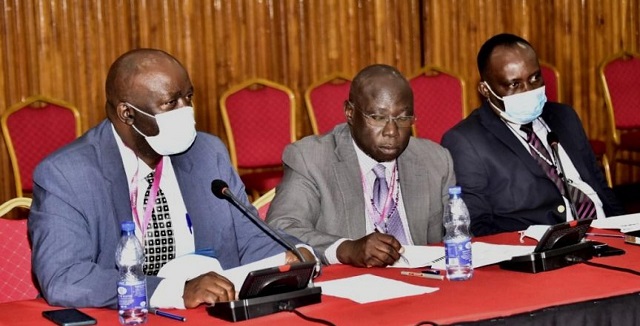
Kampala, Uganda | THE INDEPENDENT | The former Masaka Regional Referral Hospital Director, Dr. Nathan Onyachi, has acknowledged failure to seek clearance from the Attorney General for a 2.5 billion Shillings variance for the 400 bed Maternity and Children Complex project.
Dr. Onyachi and the current hospital director, Dr. James Elima on Thursday appeared before Parliament’s Public Accounts Committee (PAC)-Central Government to respond to audit queries raised in the financial year 2020/2021.
In the report, Auditor General John Muwanga reviewed the procurement of construction of a Maternity and Children’s Complex which contract was signed by the hospital on 30th May 2014, with Tirupati Development (U) Limited at a cost of 10.612 billion Shillings.
Muwanga queried that the hospital director approved a 24 percent price increment of the contract from 10.6 billion to 13.16 billion, a variance of 2.55 billion without the clearance of the Public Procurement and Disposal of Public Assets (PPDA).
The PPDA Regulations of 2014, state that a single contract amendment shall not increase the total contract by more than 15 percent of the original contract price. The regulations also stipulate that a contract amendment shall not be issued to a provider without obtaining approval from other concerned bodies including the Attorney General.
“Although the project consultant recommended for the increment of 2.55 billion shillings, no independent technical audit on the project was undertaken by Ministry of Health engineers to establish the cost of the remaining civil works and the condition of the contract. I noted that the director communicated price increment to the contractor without the approval of the Attorney General,” Muwanga reported.
The Auditor General added that in the absence of adequate documentation and required approvals, it makes it difficult to confirm the authenticity of the price increments.
Dr. Onyachi explained that the contractor submitted a price variation of up to 33 percent after six years of executing the works but the submission was scaled down to 24 percent and no other price increment submissions were to be allowed until project completion.
He said that the fresh submissions were supported by Bank of Uganda inflation data and Uganda Bureau of Statistics –UBOS price indices and verified by the project consultants.
He added that following the Auditor General’s advice, the hospital has so far submitted two variation claims to the Solicitor General for clearance and that in the last 6 months, one has been approved, while the other is pending.
According to Dr. Onyachi, since the money was released early, they were reluctant to get the necessary clearance from the Solicitor General.
“The fact that all the parties that got involved were convinced that there was a need for price increment…this was the sixth year of the contract which was supposed to be three years,” said Onyachi.
He noted that the project is currently at a 96 percent completion level.
Dismas Wandera, the procurement officer at the hospital further revealed that besides the 2.5 billion project variance, they are also faced with another 1.7 Billion Shillings additional budget for the project that is to cater for several extra works.
Sarah Opendi, the Tororo Woman MP wondered why the government would allow a three-year contract to drag on without releasing money in time. Fredrick Angura, the Tororo South MP also noted the same problem at Arua hospital.
Michael Mawanda, the Igara East MP expressed concern that the projected figure will increase and cost the taxpayer.
Onyachi assured the MPs that the project money was not going to increase further, saying that the extra required money of 1.7 billion was budgeted for in the budget for the current financial year 2022/2023.
He said that the current maternal and child health wards in the hospital are over 80 years old and that they are interested in moving into the new building.
Opendi also faulted the Ministry of Finance for failing to release funds within the project’s initial period. The committee is scheduled to interface with the Ministry of Health officials together with those of Finance regarding the different delayed projects in health facilities.
*****
URN
 The Independent Uganda: You get the Truth we Pay the Price
The Independent Uganda: You get the Truth we Pay the Price



PAC: as you look into performance of regional referral hospitals
Please familiarise with a book showing the Laboratory menu
There is a service that is not being adequately offered right from health center III; BUT all cases from lower level can be referred to a regional facility
So from that book determine if these hospitals get a constant supply of chemistry and haematology reagents and supplies from the center
The population deserves better
It is good to identify an item from an area of service to serve as an indicator for bench marking
Among the diagnostics, it looks like the radiology unit is serving that purpose
No complaint
But the HIV/AIDS care and support activity had delivered units for (a)monitoring blood levels and blood counts (b) monitoring function of liver, kidney, other components of body function and metabolism (c) monitoring the amount of Virus in the blood
Furthermore the care of patients as a routine involves laboratory investigations to back up and or rule out other possibilities at the time of making a diagnosis
All these diagnostic activities require machines with associated reagents, and controls. Such machines also require periodic calibration and maintenance
There may be need of specific diagnostic kits
It is dis heartening to see a patient with high blood pressure, with no investigations (sickness does not strike when the pocket is full)
So one is interested in an uptodate finding of sustained presence of that component of diagnostic with a view to ensure adequate care
Even if you wish to emphasise primary health care, the well being of the population should be monitored
Prevent
Early detection of problems, then manage
Even those who deteriorate should be maintained
The care of mothers ( the indicator of services), is sustained by checking their well being
When they make first contact
When they need the coveted caserian section
When they get complications
So if last consignment is in months “X” and some requirements missing